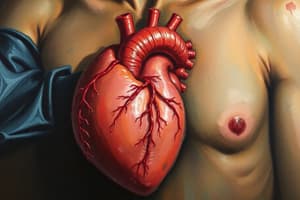Podcast
Questions and Answers
What does the equation $SV = \frac{CO}{HR}$ represent in hemodynamic measurements?
What does the equation $SV = \frac{CO}{HR}$ represent in hemodynamic measurements?
- The calculation of stroke volume from cardiac output and heart rate (correct)
- The cardiac index calculation based on body surface area
- The relationship between systemic vascular resistance and cardiac output
- The measure of work performed by the ventricles in pumping blood
Which formula correctly calculates the left ventricular stroke work index (LVSWI)?
Which formula correctly calculates the left ventricular stroke work index (LVSWI)?
- LVSWI = SVI \times (PA - CVP) \times 0.0136
- LVSWI = SVI \times (MAP - CVP) \times 0.0136
- LVSWI = SVI \times (PA - CVP) \times 0.0136 g/mL (correct)
- LVSWI = SVI \times (PCWP - CVP) \times 0.0136
In the context of hemodynamics, what does the term 'indexed by BSA' imply?
In the context of hemodynamics, what does the term 'indexed by BSA' imply?
- Cardiac measurements are adjusted for body surface area (correct)
- Measurements are adjusted for heart rate differences
- Direct measurements are recalculated using indirect values
- Blood flow is measured by calculating surface area only
How is pulmonary vascular resistance (PVR) calculated?
How is pulmonary vascular resistance (PVR) calculated?
What does a high pulmonary vascular resistance (PVR) indicate?
What does a high pulmonary vascular resistance (PVR) indicate?
What is the significance of an indexed measurement in hemodynamics?
What is the significance of an indexed measurement in hemodynamics?
Which component is essential for calculating the left ventricular stroke work index (LVSWI)?
Which component is essential for calculating the left ventricular stroke work index (LVSWI)?
What does the formula for systemic vascular resistance (SVR) imply about blood pressure dynamics?
What does the formula for systemic vascular resistance (SVR) imply about blood pressure dynamics?
Why is it important to measure both right and left ventricular stroke work indices (RVSWI and LVSWI)?
Why is it important to measure both right and left ventricular stroke work indices (RVSWI and LVSWI)?
What does a pulmonary artery (PA) catheter provide in critically ill patients?
What does a pulmonary artery (PA) catheter provide in critically ill patients?
Flashcards are hidden until you start studying
Study Notes
Hemodynamics
- The study of forces that affect blood flow
- A pulmonary artery (PA) catheter can provide useful information for critically ill patients
- Direct measurements can be used to calculate indirect measurements
Direct Measurements
- Stroke Volume (SV) is the amount of blood ejected from the ventricle with each heartbeat
- SV = Cardiac Output (CO) ÷ Heart Rate (HR)
- Stroke Volume Index (SVI)adjusts SV for body size
- SVI = SV ÷ Body Surface Area (BSA)
- Cardiac Index (CI) adjusts CO for body size
- CI = CO ÷ BSA
- Right Ventricular Stroke Work Index (RVSWI) and Left Ventricular Stroke Work Index (LVSWI) represent the amount of work required by the ventricles to pump blood
- LVSWI = SVI x (Pulmonary Artery Pressure (PA) - Central Venous Pressure (CVP) x 0.0136 g/mL = gm/m2
Vascular Resistance
- Pulmonary Vascular Resistance (PVR) is the resistance to blood flow in the pulmonary circulation
- PVR = [(PA - Pulmonary Capillary Wedge Pressure (PCWP))/CO] x 80
- Systemic Vascular Resistance (SVR) is the resistance to blood flow in the systemic circulation
- SVR = [(Mean Arterial Pressure (MAP) - CVP)/CO] x 80
Hemodynamics
- Hemodynamics studies forces that affect blood flow
- A Pulmonary Artery (PA) catheter can be inserted into critically ill patients to provide vital information
- Direct measurements can be used to calculate indirect measurements
- Some measurements are "indexed" by Body Surface Area (BSA)
Direct Measurements
- Stroke Volume (SV): SV = Cardiac Output (CO) / Heart Rate (HR)
- Stroke Volume Index (SVI): SVI = SV / BSA
- Cardiac Index (CI): CI = CO / BSA
- Right Ventricular Stroke Work Index (RVSWI) and Left Ventricular Stroke Work Index (LVSWI): measures the work required by the ventricles to pump blood
- LVSWI = SVI x (Pulmonary Artery Pressure [PAP] - Central Venous Pressure [CVP]) x 0.0136 g/mL = gm/m2
- Vascular Resistance
- Pulmonary Vascular Resistance (PVR): PVR = [(PAP – Pulmonary Capillary Wedge Pressure [PCWP])/CO] x 80
- Systemic Vascular Resistance (SVR): SVR = [(Mean Arterial Pressure [MAP] – CVP)/CO] x 80
PVR
- High PVR indicates a problem with the pulmonary circulation, which leads to a higher pressure needed to push blood through the lungs
- High PVR can be caused by conditions like pulmonary hypertension, lung disease, and heart failure
- Low PVR indicates that the pulmonary circulation is working well, and the pressure needed to push blood through the lungs is low
Studying That Suits You
Use AI to generate personalized quizzes and flashcards to suit your learning preferences.




